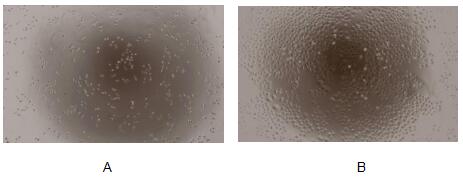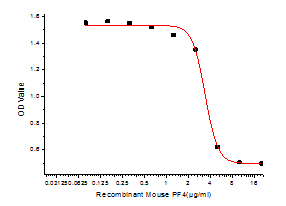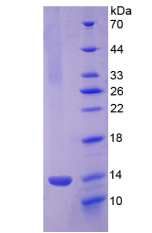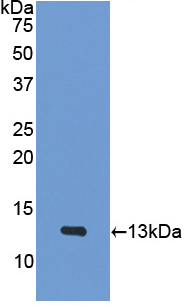
Details
ACTIVITY TEST
Buffer Formulation 20mM Tris, 150mM NaCl, pH8.0, containing 1mM EDTA, 1mM DTT, 0.01% SKL, 5% Trehalose and Proclin300. Traits Freeze-dried powder Purity > 90% Isoelectric Point 9.4 Applications Cell culture; Activity Assays.

Platelet factor 4 (PF4) is a small cytokine belonging to the CXC chemokine family that is also known as chemokine (C-X-C motif) ligand 4 (CXCL4). This chemokine is released from alpha-granules of activated platelets during platelet aggregation, and promotes blood coagulation by moderating the effects of heparin-like molecules. Due to these roles, it is predicted to play a role in wound repair and inflammation. To measure its ability to inhibit the FGF basic-dependent proliferation of HUVEC human umbilical vein endothelial cells, HUVEC cells were seeded into 96-well plates at a density of 3,000 cells/well with 2% serum standard DMEM including 1μg/mL recombinant human FGF1 and various concentrations of recombinant human PF4. After incubated for 48h, cells were observed by inverted microscope and cell proliferation was measured by Cell Counting Kit-8 (CCK-8). Briefly, 10µL of CCK-8 solution was added to each well of the plate, then the absorbance at 450nm was measured using a microplate reader after incubating the plate for 1-2 hours at 37℃. Proliferation of HUVEC cells after incubation with PF4 for 48h observed by inverted microscope was shown in Figure 1. Cell viability was assessed by CCK-8 (Cell Counting Kit-8) assay after incubation with recombinant human PF4 for 48h. The result was shown in Figure 2. It was obvious that PF4 significantly FGF basic-dependent proliferation of HUVEC cells. The ED50 is 3.4μg/mL.
(A)HUVEC cells cultured in DMEM with 1μg/mL FGF1, stimulated with 5μg/mL PF4 for 48h;
(B) Unstimulated HUVEC cells cultured in DMEM with 1μg/mL FGF1 for 48h.
Figure. Inhibition of HUVEC cells proliferation after stimulated with PF4.
Figure. Inhibition of FGF basic-dependent HUVEC proliferation after stimulated with PF4.
USAGE
Reconstitute in 20mM Tris, 150mM NaCl (PH8.0) to a concentration of 0.1-1.0 mg/mL. Do not vortex.
STORAGE
Avoid repeated freeze/thaw cycles. Store at 2-8°C for one month. Aliquot and store at -80°C for 12 months.
STABILITY
The thermal stability is described by the loss rate. The loss rate was determined by accelerated thermal degradation test, that is, incubate the protein at 37°C for 48h, and no obvious degradation and precipitation were observed. The loss rate is less than 5% within the expiration date under appropriate storage condition.
Image

Figure. SDS-PAGE

Sample: Recombinant PF4, Mouse;
Antibody: Rabbit Anti-Mouse PF4 Ab (PAA172Mu01)
Figure. Western Blot
Bought notes(bought amounts latest0)
User Comment(Total0User Comment Num)
- No comment


 +86 571 56623320
+86 571 56623320
 +86 18668110335
+86 18668110335

